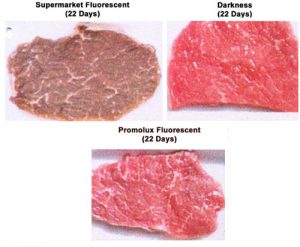Ultraviolet Light in Fresh Beef Display Cases

Early studies found that beef stored in the dark over a period of three to ten days did not change color significantly, while beef stored under fluorescent lighting for the same amount of time began to turn brown after only 5 days.
In a 28 day study conducted at the University of Zaragoza in 2000, ultraviolet light was shown to have a profound effect on the rate of beef spoilage and the creation of metmyoglobin, the pigment that gives meat a brownish surface color. All fresh beef in this study were packaged in a modified atmosphere of 70% oxygen, 20% carbon dioxide, and 10% nitrogen.
Beef displayed under Promolux lamps and regular fluorescent lights with a Promolux filter, which both block UV radiation, maintained virtually the same bright red color, fresh smell, low bacterial count, and low levels of metmyoglobin as beef stored in the dark, while beef displayed under a standard supermarket fluorescent light became brown and decomposed rapidly after only 12 days.
After 17 days, meat under regular supermarket lighting had much larger percentages of surface metmyoglobin, higher levels of psychrotrophic bacteria, and poorer odor quality than the beef displayed under Promolux lights or Promolux filters, or beef kept in darkness.
This study proved that ultraviolet light as emitted by standard retail fluorescent lamps accelerates bacteria growth, the brown discoloration of beef caused by high concentrations of metmyoglobin, and lipid oxidation which leads to rancidity.
